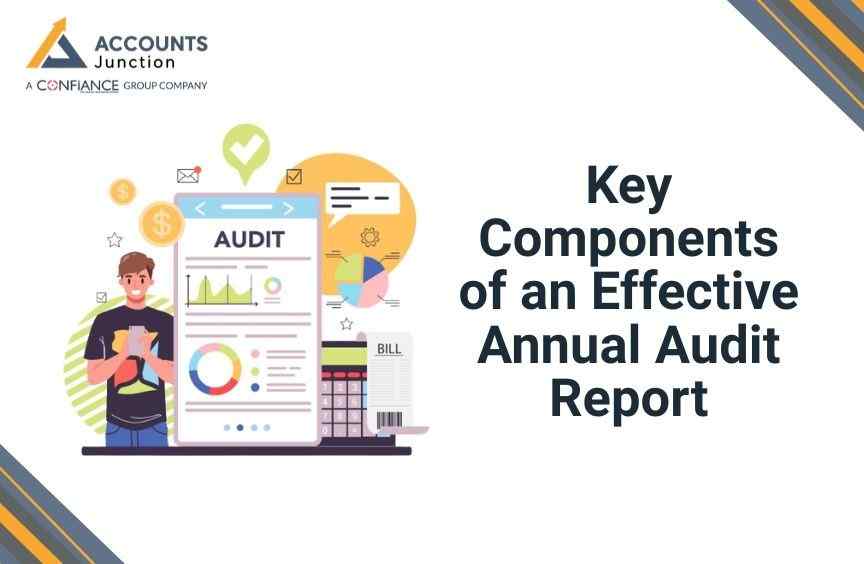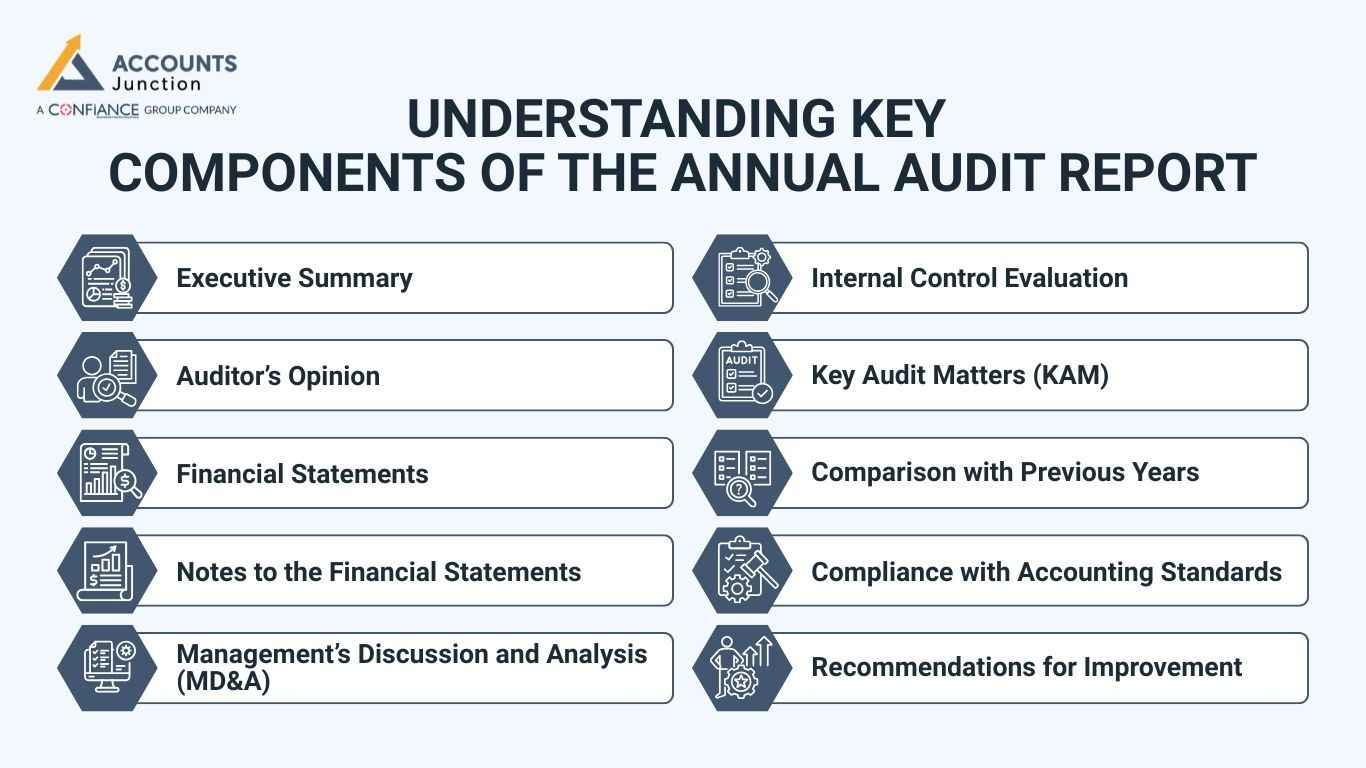
Key Components of an Effective Annual Audit Report
An annual audit report is a key document that shows a company’s financial health. It helps owners, investors, and regulators see how well the business is doing. The report includes core financial data, notes, and results from the audit process. This report goes beyond just satisfying a legal requirement: it builds trust and affirms transparency in all aspects of the company, thereby also providing the basis for informed decisions with respect to the company's future.
This guide will explain the main parts of a strong Annual Audit Report. If you are a business owner, investor, or accountant, this should make your understanding of auditing easier.
Understanding key components of the Annual Audit Report
1. Executive Summary
An annual audit report starts with an executive summary. This part gives a quick view of the audit results. It covers the audit scope, method used, and main findings. The summary helps readers see key points without reading the full report. It also points out any big issues found in the financial audit and shares the auditor's view on the company's finances.
2. Auditor’s Opinion
One significant element of a financial audit is the auditor's opinion. The audit opinion indicates to what extent the auditor believes that the financial statements properly present the financial position and performance of the company. It can be:
- Unqualified Opinion: This is the best type of opinion. It means the financial statements are true and fair.
- Qualified Opinion: There are some issues, but the financial statements are mostly correct.
- Adverse Opinion: The statements are wrong and do not follow the rules.
- Disclaimer of Opinion: Given that sufficient evidence could not be obtained, an opinion could not be issued.
An unqualified opinion in the annual audit report implies that the financial statements are a true and fair view and are reliable.
3. Financial Statements
Financial statements are a key part of any financial report. They show how the company is doing and what its financial position looks like. An annual audit report includes the following main financial statements:
- Balance Sheet
The balance sheet shows the company’s financial state at a specific time. It lists what the company owns (assets), what it owes (liabilities), and the owners' share (equity). The core rule behind it is:
Assets = Liabilities + Equity - Income Statement
This report shows how the company performed over a set period. It lists income and costs, ending with the net profit or loss. It helps explain how much the company earned or lost. - Cash Flow Statement
The report is meant for keeping track of cash inflow and cash outflow activities of the business. Such activities are classified into three categories - operating, investing, and financing. It shows how well the company handles its cash. - Statement of Changes in Equity
This report shows how the value of ownership changed over time. It includes profits, dividends, and stock changes. It gives a clear view of shifts in the company’s equity.
The statements must be prepared according to accounting standards and principles. They must also be subject to review during the financial audit to establish their accuracy and completeness.
4. Notes to the Financial Statements
The notes section gives extra details about the numbers in the financial statements. It explains the rules, methods, and ideas used in the reports. For example, it may show changes in accounting methods or unusual transactions. This section supports clarity and helps readers better understand the financial audit.
5. Management’s Discussion and Analysis (MD&A)
Management's Discussion & Analysis (MD&A) is an integral part of the Annual Auditing Report. This is a section of the report in which company management explains in layman's terms the financial results. It adds context to the figures shown in the financial statements. It may include insights on:
- Future growth prospects
- Potential risks
- Operational strategies
- Any challenges faced during the reporting period
The MD&A helps people figure out the financial results of the company from a management view. It is an important part of the financial audit, depicting the efficiency of management in utilizing the resources of the company.
6. Internal Control Evaluation
An internal control evaluation review is something very crucial in an annual audit report. Such an evaluation views the company in terms of how it manages its financial reporting systems. Strong controls help reduce errors and fraud risks. Auditors suggest improvements if weaknesses are found.
Internal controls are essential for accurate financial reporting. They help prevent mistakes and wrong entries in the financial report.
7. Key Audit Matters (KAM)
In some audits, the annual audit report has a part called Key Audit Matters (KAM). These are audit areas that took more time or care because they were hard or key to the report. KAMs help readers see which areas were harder to audit or needed extra care. This section adds to the clarity and trust of the financial audit process.
8. Comparison with Previous Years
A strong annual audit report will compare this year’s financial results with past years. Such an analysis would be beneficiary to stakeholders to estimate whether the company is growing or struggling. A comparative study could reveal patterns of profitability, revenue, costs, and cash flow. Such trends can be considered key in knowing the financial health and the stability of the company over time.
9. Compliance with Accounting Standards
A well-made annual audit report shows that the company follows rules like GAAP or IFRS.
These rules help keep the reports correct and clear. They also simplify comparisons with other companies.
During the audit, auditors verify if these rules are being followed. If they find any problems, the report points them out.
Such problems can harm the trust people have in the company.
10. Recommendations for Improvement
If the audit finds any problems, the auditor may give advice to fix them. These tips may be about reports, controls, or other money-related areas. Acting on these suggestions can help improve financial practices and avoid future problems.
At Accounts Junction, we provide clear and detailed annual audit reports. Our reports help your business stay transparent and follow the rules. Our skilled team offers trusted financial audits. We help you make smart choices and reach your financial goals. Count on us to handle your financial reports with care.
FAQs
1. What is an Annual Audit Report?
- It is a document that reviews a company’s financial statements and shows whether they present a fair and accurate view.
2. Why is an Annual Audit Report important?
- It builds trust with investors, management, and regulators by showing transparency in financial reporting.
3. Who prepares the Annual Audit Report?
- Certified auditors or licensed accounting firms prepare it after examining the company’s financial records.
4. How often is an Annual Audit Report done?
- It is typically prepared once every financial year after the company’s year-end.
5. What does the auditor’s opinion in an Annual Audit Report indicate?
- It shows whether the financial statements are reliable and whether they follow accounting standards.
6. What is included in the executive summary of an Annual Audit Report?
- It provides a quick overview of audit scope, key findings, and any significant issues.
7. Why are financial statements important in an Annual Audit Report?
- They show the company’s assets, liabilities, income, cash flow, and changes in equity in a clear format.
8. What are Key Audit Matters (KAM) in the report?
- These are areas of the audit that required extra attention due to complexity or risk.
9. How does the Management Discussion and Analysis (MD&A) section help?
- It explains the financial results, challenges, and future plans in simple, understandable terms.
10. Why is internal control evaluation included in an Annual Audit Report?
- It assesses how well the company prevents errors and fraud in its financial reporting.
11. What is the role of notes to financial statements?
- They clarify numbers, accounting methods, and unusual transactions for better understanding.
12. How does an Annual Audit Report show compliance with accounting standards?
- It confirms whether financial statements follow GAAP, IFRS, or other relevant rules.
13. Why are comparisons with previous years included in the report?
- They highlight trends in revenue, profit, cash flow, and financial stability over time.
14. Can an Annual Audit Report help a company make better decisions?
- Yes, it may reveal weaknesses and suggest improvements to strengthen financial management.
15. What does a qualified opinion in the Annual Audit Report mean?
- It indicates the statements are mostly accurate but contain minor issues or exceptions.
16. What is an adverse opinion in an Annual Audit Report?
- It means the financial statements do not present a true and fair view of the company’s finances.
17. Can small companies benefit from an Annual Audit Report?
- Yes, it can improve transparency, credibility, and stakeholder confidence, even for smaller firms.
18. How are risks addressed in an Annual Audit Report?
- The report may highlight financial or operational risks and suggest ways to mitigate them.
19. Why are recommendations included in an Annual Audit Report?
- Auditors provide suggestions to improve reporting, internal controls, and overall financial health.
20. How does a well-prepared Annual Audit Report impact stakeholders?
- It may increase trust among investors, management, and regulators by showing clear, accurate, and reliable financial information.

